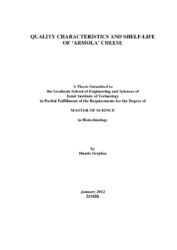Please use this identifier to cite or link to this item:
https://hdl.handle.net/11147/3168Full metadata record
| DC Field | Value | Language |
|---|---|---|
| dc.contributor.advisor | Korel, Figen | en |
| dc.contributor.author | Orşahin, Hande | - |
| dc.date.accessioned | 2014-07-22T13:51:01Z | - |
| dc.date.available | 2014-07-22T13:51:01Z | - |
| dc.date.issued | 2012 | en |
| dc.identifier.uri | http://hdl.handle.net/11147/3168 | - |
| dc.description | Thesis (Master)--Izmir Institute of Technology, Biotechnology, Izmir, 2012 | en |
| dc.description | Includes bibliographical references (leaves: 74-79) | en |
| dc.description | Text in English; Abstract: Turkish and English | en |
| dc.description | xi, 102 leaves | en |
| dc.description | Full text release delayed at author's request until 2015.02.13 | en |
| dc.description.abstract | In this study, forty Armola cheese samples were collected from dairies located in Seferihisar, İzmir and their physicochemical, microbiological and sensorial quality characteristics were investigated. In addition, the lactic acid bacteria flora of cheese samples was identified using genotyping method (16S-rRNA gene sequencing). The average total solid, fat, and protein contents, pH value, titratable acidity, water activity and salt content of these samples were found as 37.26, 19.52, 10.87, 4.70, 0.95, 0.91, and 2.51, respectively. The average microbial counts were found as follows: Total aerobic mesophilic bacteria, 7.82; psychrotrophic bacteria, 6.98; coliform bacteria, 4.56; lactococci, 7.55; lactobacilli, 7.87; enterococci, 6.17; yeast 7.33; mold <1.00; Staphylococcus spp., 5.94; and Listeria spp., 2.94 cfu/g. The high microbial counts showed that most of these samples were produced in very poor hygienic conditions. As a result of the descriptive sensory analysis, dominant flavor were salty and sour as basic taste; however, creamy, cooked and whey tastes were as aromatics. According to genotyping identification results, the dominant bacteria were found as Enterococcus ratti, Enterococcus durans, Enterococcus hirae, Streptococcus lutetiensis, Streptococcus equines, Streptococcus luteciae, Lactobacillus paracasei subsp. tolerans, Lactobacillus casei subsp. casei, Lactobacillus zeae, and Lactobacillus paracasei subsp. paracasei. Due to the short shelf-life of Armola cheese, antimicrobials, Nisaplin®, Natamax®, and Microgard TM 100, were also used alone or in combination to extend the shelf-life of the product. Microbiological, sensory, color and pH analyses were conducted during storage. Because of the inhibition effects on yeasts, Natamax® and its combinations were the most effective on extending the shelf-life. | en |
| dc.language.iso | en | en_US |
| dc.publisher | Izmir Institute of Technology | en |
| dc.rights | info:eu-repo/semantics/openAccess | en_US |
| dc.subject.lcsh | Cheese--Microbiology | en |
| dc.subject.lcsh | Cheese--Analysis | en |
| dc.subject.lcsh | Food--Shelf-life dating | en |
| dc.title | Quality characteristics and shelf-life of 'Armola' cheese | en_US |
| dc.type | Master Thesis | en_US |
| dc.institutionauthor | Orşahin, Hande | - |
| dc.department | Thesis (Master)--İzmir Institute of Technology, Bioengineering | en_US |
| dc.relation.publicationcategory | Tez | en_US |
| item.fulltext | With Fulltext | - |
| item.grantfulltext | open | - |
| item.languageiso639-1 | en | - |
| item.openairecristype | http://purl.org/coar/resource_type/c_18cf | - |
| item.cerifentitytype | Publications | - |
| item.openairetype | Master Thesis | - |
| Appears in Collections: | Master Degree / Yüksek Lisans Tezleri | |
Files in This Item:
| File | Description | Size | Format | |
|---|---|---|---|---|
| 423757.pdf | MasterThesis | 1.41 MB | Adobe PDF |  View/Open |
CORE Recommender
Page view(s)
210
checked on Nov 18, 2024
Download(s)
148
checked on Nov 18, 2024
Google ScholarTM
Check
Items in GCRIS Repository are protected by copyright, with all rights reserved, unless otherwise indicated.